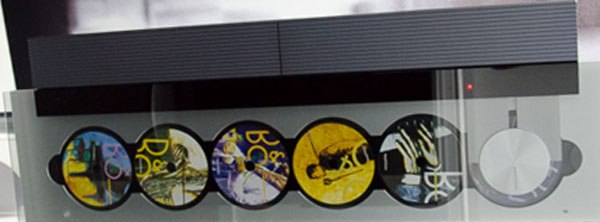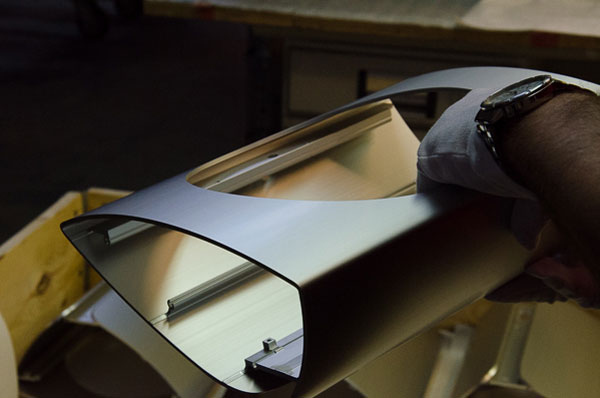Behind the Scenes at Bang & Olufsen


After being picked up from the Billund airport and driving through miles of flat cornfields and small towns with cobblestone streets and brick houses, we arrived at the headquarters, which houses research and development, design, and testing operations for the company Peter Bang and Svend Olufsen founded in 1925. Known simply as “the Farm,” the modern boxy structure overlooks a pasture where sheep roam between a horseshoe configuration of buildings that share the same clean lines and simple design that one finds in B&O's products.

In the foyer of the main building the company mission is proudly displayed for all to see: “Bang & Olufsen exists to move you with enduring magical experiences.” And magic did seem to permeate the air as we walked through the building. Lights turned themselves on and doors opened as we approached, as if to welcome us through.

The tour started with a look at past B&O prototypes, which were created using many materials. For one sample, Legos were used to simulate the wheel of the BeoSound 5—perhaps to pay homage to the birthplace of Legos and Legoland in nearby Billund. In this initial stage of product design, multiple prototypes are created until a distinctly Bang & Olufsen design has been achieved.

Our next stop was “the cube,” an empty square of a room measuring about 40 x 40 x 43 feet, which B&O claims to be one of the largest, privately owned electroacoustic measurement facilities in the world. We stood on a platform more than 30 feet above the floor as Tonemeister, Geoff Martin, explained how speakers are tested and their timbre shaped. The speaker being tested is subject to a battery of measurements while suspended in the middle of the anechoic chamber on a small shelf held by a crane.

“I work in the acoustics department with engineers but I’m not an engineer,” Martin explains while clutching a pile of audio measurements. “I’m a musician. I get to sit down at the end of the development process. I listen to music and complain (about the speaker’s sound) and the engineers fix it.” And because B&O speakers are active, with built-in amplifiers and processing, careful attention is paid to the “digital sound engine” and its affect on the sound. In the end, the goal is to reproduce as perfectly as possible the intentions of the artist and producer who presided over the original recording.

Once adjustments have been made, every speaker is subject to blind listening tests in a small “living room” with a couple dozen chairs facing a curtain that hides the speakers under scrutiny. To avoid any prejudices, the presenter mixes other brand speakers in with the B&O speakers being evaluated. During the listening session I participated in, sound from an unknown speaker was above average and clear, with good imaging, but not what I expected from a B&O speaker. And then came the revelation: what we were listening to was not a speaker at all—it was the BeoVision 11 television.

From the listening room, we descended into the concrete basement, an appropriate venue for the “torture chamber” we were about to experience—a place where machines test robustness by dropping, banging, and shaking products. Speakers also undergo life testing that mimics years of use—refreshing in a world where obsolescence is planned.

If you’ve ever received a product that is defective due to poor handling in shipping or owned a remote that chipped or cracked when dropped or had buttons that stick and lettering that has faded away, you will appreciate the extensive wear-and-tear testing done at this facility. We watched as remotes were dropped repeatedly from a height of 4 feet and then baked with hand lotion and sweat to make sure labels don’t fade. Product surfaces were scratched, frozen, shaken for hours, and exposed to the equivalent of three years of direct sunlight. My favorite torture device simulates years of exposure to smoking by lighting up 120 cigarettes a day and puffing smoke into an airtight box. What happens to products that don’t survive a torture routine? They’re sent back to the design team, which is charged with the task of finding another material or construction that can withstand the torment.

In the final torture chamber, products are placed in an airtight compartment and subject to extreme heat and cold while being shaken vigorously. The purpose is to find the weak link—a screw that comes loose or material that separates— and send the product back to the engineering team for fixing.

We had lunch while watching sheep graze in the nearby field before being led to Factory 5, where B&O fabricates and finishes its own aluminum parts, including acoustic len structures, encasements for the grilles of BeoLab 17 speakers, and the distinctive rings used on the BeoSound 5. The aluminum is anodized to and tinted for additional style. Workers must check every piece of metal piece and sign off on it to verify that it’s up to B&O standards before it is sent to a massive enclosure where robots do final carving and polishing or, in the case of a grille cover for the BeoVision 12 speaker, drill 5,800 holes.

When the day was done, I reflected on what had been a fascinating look at a company known around the world for making AV products with memorable designs, lasting quality, and solid audio and video performance. It's unlikely that I'll be investing $11,000 in a BeoVision 12 TV any time soon, but I certainly can appreciate the magic that goes into creating one.
























































